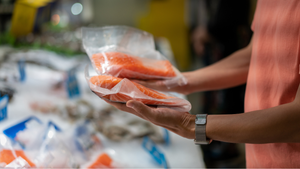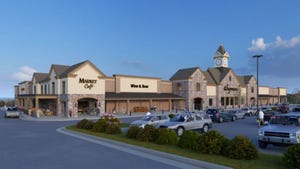'Be Bold': FMI Closing Keynote Maps a Tough Road Ahead for a Resilient Industry
Retailers have 'no option' but to slash costs as they work toward a new operating model, McKinsey's Sajal Kohli says. Food retailers have "no option" but to slash costs and develop an operating model for the new normal, McKinsey's Sajal Kohli said in a rapid-fire closing keynote of FMI's annual Midwinter Executive Conference.
In a wide ranging and rapid-fire closing keynote presentation to FMI’s Midwinter Executive Conference, McKinsey’s Sajal Kohli crammed dozens of insights and recommendations into a 25-minute talk urging food retailers to act with purpose and determination as they navigate a future transformed by omnichannel and technology, and shaken by the global pandemic.
In short, retailers will have to drastically reduce their expenses, intrepidly pursue new places and partners for growth, and tackle profitable online selling, personalized marketing and a crisis-proof supply chain, while developing a new operating model to withstand those challenges, said Kohli, a senior partner of McKinsey leading its Global Retail and Consumer Packaged Goods Practice.
“When we look at companies that have shown resilience to past downturns, we see that they’ve made bold decisions regarding their organization and operating model, which determine their success,” Kohli said. “Leading organizations can make moves that will sustain their growth and advantage for years to come, but they must be bold.”
In his address, Kohli identified five “critical imperatives that grocers absolutely need to get right,” and each of those with recommendations, as follows:
Getting E-Commerce to Profitability
The unprecedented acceleration of e-commerce has been a “double-edged sword” for retailers that have seen sales and customer acquisition “at a clip only imaginable in their wildest dreams” but with wildly varying net margins on the business.
Depending on the various labor and fulfillment models, McKinsey research indicates net margins ranging from negative 20% on omichannel to plus 5%, driven by cost variances, product handling and last-mile and third-party fees.
“This will necessarily require a more bespoke and tailored approach to pick and delivery models depending on your footprint and your operation based on the labor and transportation realities you face in each of your businesses and markets,” he said.
Make a Permanent Shift From Mass to Personalized Marketing
 Personalization in grocery has traditionally lagged other sectors of retail like apparel and beauty, “but it’s quickly getting momentum,” Kohli said, particularly for those such as Kroger with in-house capabilities like its 84.51 data group.
Personalization in grocery has traditionally lagged other sectors of retail like apparel and beauty, “but it’s quickly getting momentum,” Kohli said, particularly for those such as Kroger with in-house capabilities like its 84.51 data group.
“We know that at scale, personalization is proven its potential beyond revenue,” he said. “It’s a marketing efficiency play. It’s a critical enabler of customer engagement, and a driver of new customer acquisition.”
The industry is getting the message. “Historically digital marketing represented a meager 5% to 10% of a marketing budget. Yet many grocers are budgeting close to 50% for 2021 and 2022,” Kohli said. “With that shift comes an arms race to build a better marketing tech stack and operating model to drive rapid campaign deployment with a test-and-learn engine underpinning the approach.”
Embrace COVID-Resilient Merchandising
The financial downturn brought on by the pandemic will eventually play itself out in consumer food shopping choices, Kohli asserted, and will reward retailers that are prepared to offer value along with excitement.
“It’s crucial that retailers bring affordability and availability to the everyday shopper during and beyond the pandemic,” he said. “We believe that retailers have a real opportunity to drive accelerated private label penetration and reinvigorate stale categories with flavors, ingredients and ways of preparation that are both exciting and approachable for home cooks.
“Customers have never been more open to exploring and switching, [so] now is the perfect time to build loyalty and differentiation through store brands,” he continued. “There might’ve been an abundance of shooting from the hip during the early days of the pandemic, but now is the time to double down on optimizing assortment planning and forecasting as the pandemic continues.”
And with COVID bringing lots of questions as to the right assortment for stores, he recommended that retailers:
Evolve assortment planning to plan in a truly omnichannel way.
Consider end-to-end supply chain implications of buying decisions.
Unlock new sources of margin value like digital shopper marketing dollars “to go deeper and broader and be more precise,” in pricing. “So for example, instead of understanding customer price sensitivity at the national/category level, you will have to build out to the store level and item level,” he said.
Reshape the Supply Chain
Strategic retailers should view the supply chain not as a cost center but a “strategic asset,” Kohli said.
“Prior to the pandemic the primary focus of supply chain was to deliver goods on time and at the lowest cost per case. Demand was largely predictable and resilience was really an afterthought,” he said.
But performance in the pandemic, he argued, aligned closely with those with the best product availability, with in-stock rates rebounding with the winners much quicker than those who lost share.
His five recommendations for the supply chain—each coming with their own questions—are as follows:
Challenge each node’s role in the supply chain. “What are the possibilities for dark stores or dark kitchens?”
Embrace collaboration. “What partnerships can help us improve our total cost to serve while enabling fulfillment, flexibility and rapid inventory deployment?”
Build resilience in the supply chain. “What are [the] contingencies? What level of strategic fragmentation is desirable in our supplier base, depending on product criticality?”
Focus on rapidly deployable, bespoke or tailored analytics. “How can we get a picture of true demand given the product substitution factor with the rise of online grocery delivery?” “What spikes will happen in which categories and where can we get ahead of it?”
Prioritize end-to-end visibility. “How quickly can you set up a supply chain control tower to orchestrate operations as volatility in demand continues to persist?”
An Operating Model for the ‘New Normal’
Kohli made no secret of his contention that retailers need to reduce personnel and other expenses by 20% to 30%. “There is no other option,” he said. “As a percent of sales, these costs need to continue to grow more slowly than the top line.”
Retailers should also prioritize their investment in growth areas at “two to three times” than other capabilities, and look to a cross-trained workforce, and use temporary and project-based workers where necessary.
Four recommendations in the new operating model:
Inorganic M&A, including value extensions, adjacent business models, acquisitions of capabilities and partnerships with suppliers, delivery partners, restaurants and digital companies, mentioning Walmart’s recent stake in TikTok as an example that could pioneer social commerce. “These partnerships are a necessary step to building powerful ecosystems that form the foundation of the fabled flywheel,” he said. “The ambition to own the customer has never been stronger and winning partners are also likely be in very short supply. So there is a race who might lay claim to the critical enablers of the flight to digital—the Instacarts, Takeoffs and AutoStores of the world. ... The key is to be bold. We know that companies that outperformed coming out of the last recession participated in 10% more and larger deals.”
Take note of the balance of power from shifting from West to East. “The time is right to look beyond the U.S. borders and bring the best of the globe to revolutionize how we work, sell and engage. … We think 40% of global consumption will come from Asia in 2030,” he said. Leaders of retail in Asia, including Alibaba's Hema, are offering groundbreaking capabilities U.S. retailers need to take note of.
Embrace the “future of work.” Food retailers are experiencing a confluence of cost pressures, including rising store and labor costs; consumer demand for more ethically sourced products; expenses to address the pandemic; and losses associated with the shift to omnichannel. And, of course, the acceleration of the margin diluted e-commerce channel. “Transformational productivity improvements through automation and AI are critical for the long term,” in this area, he said.
A new small format strategy. By 2030, 60% of the global population will live in cities, Kohli said, noting that 75% of global GDP is already generated by large cities and is on the way to about 86% from 2015 to 2030. And though suburban one-stop stores have been driving strong results in 2020, “we believe urban warfare is the name of the game longer term. Investments today in the right format will position players for sustained share,” he said. Target, with a growing fleet of city-based small stores is one example of a leader here.

Kohli closed his presentation by reiterating a message that boldness is a key to survival in the world ahead.
“This pandemic has tested the resolve of our global citizens, our social fabric, the power and effectiveness of our institutions,” he said. “One thing that is starting to be clear is how resilient we are and can be. Our supply chains are resilient. Our sector is resilient. Customers are resilient, our employees and especially our front-line heroes, they’re resilient. We do have the ability to emerge from this pandemic much stronger and much bolder. My challenge to you as leaders of essential organizations is to act as boldly.”
About the Author
You May Also Like






